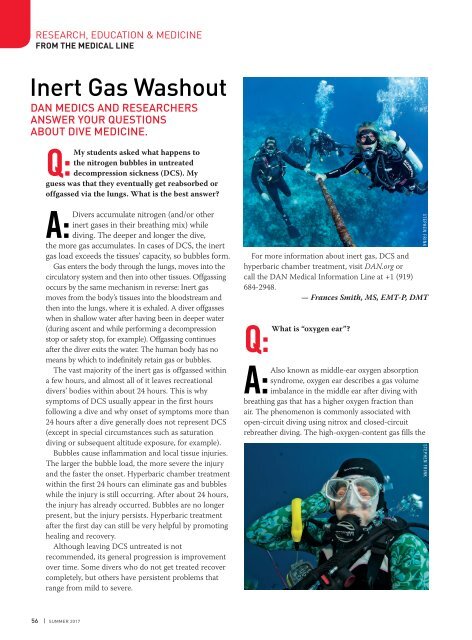AD 2017 Q3
Alert Diver is the dive industry’s leading publication. Featuring DAN’s core content of dive safety, research, education and medical information, each issue is a must-read reference, archived and shared by passionate scuba enthusiasts. In addition, Alert Diver showcases fascinating dive destinations and marine environmental topics through images from the world’s greatest underwater photographers and stories from the most experienced and eloquent dive journalists in the business.
Alert Diver is the dive industry’s leading publication. Featuring DAN’s core content of dive safety, research, education and medical information, each issue is a must-read reference, archived and shared by passionate scuba enthusiasts. In addition, Alert Diver showcases fascinating dive destinations and marine environmental topics through images from the world’s greatest underwater photographers and stories from the most experienced and eloquent dive journalists in the business.
You also want an ePaper? Increase the reach of your titles
YUMPU automatically turns print PDFs into web optimized ePapers that Google loves.
RESEARCH, EDUCATION & MEDICINE<br />
FROM THE MEDICAL LINE<br />
Inert Gas Washout<br />
DAN MEDICS AND RESEARCHERS<br />
ANSWER YOUR QUESTIONS<br />
ABOUT DIVE MEDICINE.<br />
Q:<br />
My students asked what happens to<br />
the nitrogen bubbles in untreated<br />
decompression sickness (DCS). My<br />
guess was that they eventually get reabsorbed or<br />
offgassed via the lungs. What is the best answer?<br />
A:<br />
Divers accumulate nitrogen (and/or other<br />
inert gases in their breathing mix) while<br />
diving. The deeper and longer the dive,<br />
the more gas accumulates. In cases of DCS, the inert<br />
gas load exceeds the tissues’ capacity, so bubbles form.<br />
Gas enters the body through the lungs, moves into the<br />
circulatory system and then into other tissues. Offgassing<br />
occurs by the same mechanism in reverse: Inert gas<br />
moves from the body’s tissues into the bloodstream and<br />
then into the lungs, where it is exhaled. A diver offgasses<br />
when in shallow water after having been in deeper water<br />
(during ascent and while performing a decompression<br />
stop or safety stop, for example). Offgassing continues<br />
after the diver exits the water. The human body has no<br />
means by which to indefinitely retain gas or bubbles.<br />
The vast majority of the inert gas is offgassed within<br />
a few hours, and almost all of it leaves recreational<br />
divers’ bodies within about 24 hours. This is why<br />
symptoms of DCS usually appear in the first hours<br />
following a dive and why onset of symptoms more than<br />
24 hours after a dive generally does not represent DCS<br />
(except in special circumstances such as saturation<br />
diving or subsequent altitude exposure, for example).<br />
Bubbles cause inflammation and local tissue injuries.<br />
The larger the bubble load, the more severe the injury<br />
and the faster the onset. Hyperbaric chamber treatment<br />
within the first 24 hours can eliminate gas and bubbles<br />
while the injury is still occurring. After about 24 hours,<br />
the injury has already occurred. Bubbles are no longer<br />
present, but the injury persists. Hyperbaric treatment<br />
after the first day can still be very helpful by promoting<br />
healing and recovery.<br />
Although leaving DCS untreated is not<br />
recommended, its general progression is improvement<br />
over time. Some divers who do not get treated recover<br />
completely, but others have persistent problems that<br />
range from mild to severe.<br />
For more information about inert gas, DCS and<br />
hyperbaric chamber treatment, visit DAN.org or<br />
call the DAN Medical Information Line at +1 (919)<br />
684-2948.<br />
— Frances Smith, MS, EMT-P, DMT<br />
Q:<br />
What is “oxygen ear”?<br />
A:<br />
Also<br />
known as middle-ear oxygen absorption<br />
syndrome, oxygen ear describes a gas volume<br />
imbalance in the middle ear after diving with<br />
breathing gas that has a higher oxygen fraction than<br />
air. The phenomenon is commonly associated with<br />
open-circuit diving using nitrox and closed-circuit<br />
rebreather diving. The high-oxygen-content gas fills the<br />
STEPHEN FRINK STEPHEN FRINK<br />
56 | SUMMER <strong>2017</strong>









